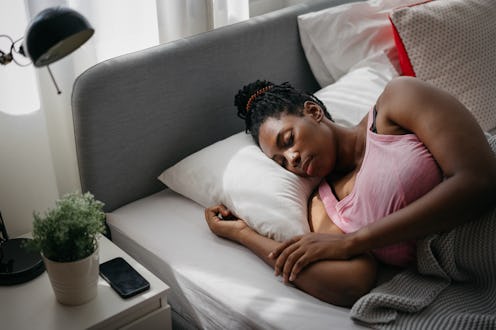Wellness
I Tried The NASA Nap & Felt Refreshed For The Whole Day
No more accidental two-hour naps.

When I nap, I nap hard. I’ll lay down for what’s supposed to be a 15-minute snooze only to wake up three hours later dizzy and confused. Naps are supposed to make you feel refreshed, reenergized, and refocused, but it’s so easy to sleep a little too long and wake up groggy and exhausted instead.
Apparently, though, there’s an ideal nap length that works with your brain’s natural sleep cycles, and according to NASA, it’s only 26 minutes long. The power nap was perfected back in 1995 when NASA found that pilots who slept for an average of 26 minutes experienced up to a 54% increase in alertness and a 34% increase in performance compared to the pilots who didn’t nap.
They found that naps that lasted more than 30 minutes allowed the astronauts to slip into a deeper stage of sleep that was tougher to wake up from. This is called sleep inertia — and it’s a real drag. As you slumber your body cycles through different sleep stages that last 90 to 120 minutes, and about 30 minutes after falling asleep you plummet into deep sleep. If you wake up in the middle of one of these cycles you’ll feel worse than if you’d even napped.
According to the Sleep Foundation, the science-backed NASA nap now refers to the quick rests you might take in the afternoon to get through the rest of your work day, but they’re also the naps I like to grab on the weekend before meeting up with friends. Here are all the benefits of the 26-minute NASA nap, including how to take one.
Benefits Of The NASA Nap
While a longer snooze might leave you feeling exhausted and out of it, a short, 26-minute NASA nap can improve your memory and creativity, boost your focus and concentration, and even fix a bad mood. Quickie naps also take the edge off that mid-afternoon sleepiness that makes your eyelids feel heavy. You know, that awful fatigue that’s untouched by extra cups of coffee.
According to Sleep.com, these NASA naps aren’t meant to replace lost sleep. You’re still supposed to get eight or more hours of rest per night. But they can help you feel refreshed enough to finish a long work shift, just like the kind tired astronauts have in space.
Another study in 2019 found that nurses who were allowed a quick, scheduled nap reported lower levels of sleepiness while at work. After snoozing they showed better job performance compared to their colleagues who weren’t allowed to rest, which goes to show the impact of the power nap.
How To Take A NASA Nap
According to the Sleep Foundation, there are a few ways to ensure you get a good NASA nap.
- Get comfy: It might be tough to find a quiet, dark place to snooze at work, but do your best to nap somewhere as peaceful as possible. Think dark, quiet, and cool — like your car with the A/C on. If you WFH, you’ll obviously have your bed or couch handy. Either way, make sure you pop on an eye mask and ear plugs to block out light and noise.
- Keep your nap short & sweet: Set an alarm for 32 minutes. The ideal NASA nap is 26-minutes long, but the recommendation is to give yourself six minutes to fall asleep and 26 total minutes of actual sleep.
- Get up ASAP: Once your alarm goes off get up and continue on with your day. Even if you’re comfortable, don’t allow yourself to continue sleeping. If you time it right, you should feel rested, refreshed, and ready to rumble.
Testing The NASA Nap
After finding out about the NASA technique, I’ve officially become the queen of napping. The simple act of setting my alarm and keeping my sleep short has made all the difference in the world, even compared to the slightly longer 45-minute naps I’ve taken in the past.
I first tested it out one weekday afternoon when I was feeling particularly tired and unfocused. Instead of struggling to stay awake at my desk, I set a timer, pulled on an eye mask, and went horizontal.
I figured I’d just rest my eyes for a few minutes, but I soon felt myself falling asleep. Before I knew it the alarm was going off and the 26 minutes had passed. I’m so used to waking up from naps in a funk, but this time I opened my eyes and noticed that I actually felt refreshed right away.
Even though it was short, the NASA nap seemed to give me a new lease on life. The world was suddenly sparkly and beautiful again — and I even had enough energy to tackle my emails. This napping style definitely comes in clutch during the work week, but it’s also been a lifesaver on the weekends.
Like the disco naps of yesteryear, NASA naps have become my new favorite way to reenergize before a night out. Instead of canceling my plans last minute and staying in because I’m tired or low-energy, I’ll hop into bed, grab a quick 26-minute snooze, and re-up my battery for a night out.
Studies referenced:
Dutheil, F. (2021.) Effects of a Short Daytime Nap on the Cognitive Performance: A Systematic Review and Meta-Analysis. Int J Environ Res Public Health. doi: 10.3390/ijerph181910212.
Hayashi, M. (1999.) The effects of a 20 min nap in the mid-afternoon on mood, performance and EEG activity. Clin Neurophysiol. doi: 10.1016/s1388-2457(98)00003-0.
Rosekind, MR. (1995.) Alertness management: strategic naps in operational settings. J Sleep Res. doi: 10.1111/j.1365-2869.1995.tb00229.x.
Tassi, P. (2000.) Sleep inertia. Sleep Med Rev. 2000 Aug;4(4):341-353. doi: 10.1053/smrv.2000.0098.
This article was originally published on